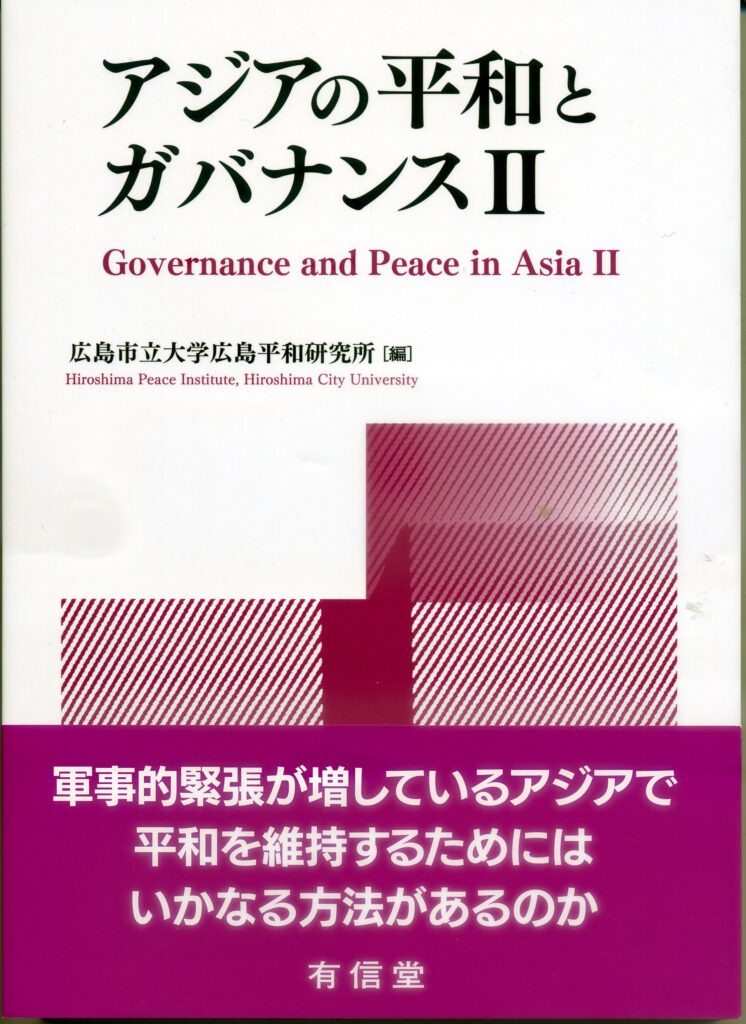沖村 理史(教授)

有信堂高文社、2025年3月刊行、
定価:3,000円+税
目次
序章 アジアのガバナンスと国際平和
1 章 バイデン政権の東アジア太平洋政策
2 章 中国の東アジア政策
3 章 韓国の東アジア政策
4 章 台湾の将来と東アジア情勢
5 章 グローバル危機と国連の役割
6 章 中国のガバナンスと核戦略
7 章 北朝鮮の核開発とガバナンス
8 章 インドの核とガバナンス
9 章 パキスタンの核開発とガバナンス
10 章 イランの核開発とガバナンス
11 章 アジアにおける人間の安全保障
12 章 アジアにおける難民
13 章 アジアの人権
14 章 アジアにおける環境と開発
15 章 インド太平洋のリージョナル・ガバナンス
16 章 ASEAN のリージョナル・ガバナンス
17 章 上海協力機構とユーラシアの新地域主義
18 章 東アジア地域形成の経緯と現状
19 章 アジアの非核地帯構想と非核規範
20 章 日本の安全保障
21 章 日本の安全保障政策と憲法
22 章 日本の安全保障政策とアメリカの核
ウクライナでも、ガザでも多くの死傷者が出ている。米大統領選でのトランプ候補の勝利に象徴されるように、
内向きの自国第一主義への支持が世界各地で広がっている。人命が失われるような紛争は遠くにあるのではなく、
アジアでも軍拡が進み、威圧的な軍事演習やミサイル発射が繰り返され、危機感が強まっている。そのような不穏
な国際情勢の中、国家ガバナンスをはかる指標の一つである民主化指標は後退している。本書の前編である『アジ
アの平和とガバナンス』で問題視したアジアの危機は、残念ながら収束に向かっておらず、ロシアのウクライナ侵
攻に代表されるグローバル危機も深刻である。その上、主要国の政治が内向きになる中で、アジアの危機を脱する
ために国家間の協力は可能なのだろうか。ロシアでもイスラエルでも一部の政治家が核兵器による恫喝を行う中で、
核なき平和の実践は達成できるのだろうか。
国際社会およびアジアの現況に対するこのような問題関心に基づき、広島平和研究所では、2025年 3 月に『アジ
アの平和とガバナンス II』(有信堂高文社)を刊行することとなった。本書の目的は、アジアの国際情勢と核開発
が進むアジア各国の国家ガバナンスを踏まえた上で、国家間協力を制度化するリージョナル・ガバナンスの進展に
ついて、前書(『アジアの平和とガバナンス』)刊行以降の 3 年間の経緯を中心に分析し、アジアの中の日本の位置
づけを明らかにすることにある。
本書は序章「アジアのガバナンスと国際平和」で提起された問題意識を踏まえ、全 5 部構成からなる。第 1 部「グ
ローバル・ガバナンスの危機と東アジアの危機」では、バイデン政権の東アジア太平洋政策、中国の東アジア政策、
韓国の東アジア政策、台湾の将来と東アジア情勢、グローバル危機と国連の役割に焦点を当て、東アジア国際関係
の危機の構造と、ウクライナ戦争下で揺れる国連の役割を論じた。第 2 部「核開発国のガバナンス」では、アジア
の核保有国および核開発の動きのある国の核開発の経緯や核戦略、および各国の自由化と民主化動向を中心とした
ガバナンス動向を検討した。分析の対象としたのは、中国、北朝鮮、インド、パキスタン、イランの 5 ヵ国である。
第 3 部「人間の安全保障」では、アジアにおける人間の安全保障を概観した上で、人権、難民、開発と環境につい
て掘り下げた分析を行った。第 4 部「アジアのリージョナル・ガバナンス」では、制度化がまばらなアジアの特徴
を踏まえ、インド太平洋のリージョナル・ガバナンスと東アジア地域形成の経緯と現状について検討し、さらに、
制度化が進む ASEAN、上海協力機構、逆に制度化が進まないアジアの非核地帯構想と非核規範についても取り上
げ、平和創造に向けたアジアの国際組織化の近年の動向と現状を明らかにした。第 5 部「アジアの中の日本」では、
主に日本の安全保障に焦点をあて、憲法およびアメリカの核兵器の役割について掘り下げた分析を行った。
本書は、広島平和研究所の教員のみならず、各分野の専門家の英知を結集して完成させた成果である。本書がア
ジアの危機と各国の現状を知るきっかけとなり、同時にアジアで国際平和を促進する手立てを考察する一助となる
ことを期待する。なお、本書は、広島平和研究所が編集した『アジアの平和と核――国際関係の中の核開発とガバ
ナンス』(共同通信社、2019年 2 月)、『アジアの平和とガバナンス』(有信堂高文社、2022年 3 月)の続編である。
本書を通じてアジアの現状を把握するのみならず、両書を合わせて参照していただき、アジアの平和をめぐる一連
の歴史的経緯への理解を深めていただきたい。
Governance and Peace in Asia II
[Ajia no Heiwa to Gabanansu II]
Tadashi Okimura (Professor)

Hiroshima City University
Yushindo Kobun-sha, Published in March 2025,
Price: 3,000 yen+tax
This article appears in the 67th issue of Hiroshima Research News.
Please click here to read back issues.
Please also refer to the Publications page.
There have been many casualties in both Ukraine and Gaza. As symbolized by the victory of Republican candidate Donald Trump in the U.S. presidential election, support for inward-looking, nationalist ideology is spreading around the world. A conflict in which lives will be lost is not far away; militarization is progressing in Asia as well, with intimidating military exercises and missile launches being carried out repeatedly, creating a growing sense of crisis. Amid such a turbulent international situation, the democratization index, one of the indices measuring national governance, is declining. Unfortunately, the crisis in Asia, which was highlighted in the prequel of this book, Governance and Peace in Asia [Ajia no Heiwa to Gabanansu], is showing no signs of being resolved, and the global crisis, represented by Russia’s invasion of Ukraine, is also serious. Moreover, as the politics of major countries turn inward, is cooperation between countries possible to overcome the crisis in Asia? With some politicians in both Russia and Israel threatening to use nuclear weapons, is it possible to achieve a nuclear-free peace?
Based on these concerns about the current situation in the international community and Asia, the Hiroshima Peace Institute has published Governance and Peace in Asia II [Ajia no Heiwa to Gabanansu II] (Yushindo Kobun-sha) in March 2025. The purpose of this book is to analyze the progress of regional governance, which supports the institutionalization of interstate cooperation, over the three years since the publication of our previous book, Governance and Peace in Asia, in light of the international situation in Asia and the national governance of Asian countries developing nuclear weapons, thereby clarifying Japan’s position in Asia.
This book is divided into five parts based on the issues raised in its Introduction, “Asian Governance and International Peace.” Part 1, “The Crisis in Global Governance and the Crisis in East Asia,” discusses the structure of the crisis in international relations in East Asia and the unstable role of the United Nations amid the war in Ukraine, focusing on the Biden administration’s East Asia-Pacific policy, China’s East Asia policy, South Korea’s East Asia policy, the future of Taiwan and the situation in East Asia, and the global crisis and the role of the United Nations. Part 2, “Governance of Nuclear-Developing Countries,” examines the history of nuclear development and nuclear strategies of Asian nuclear powers and countries moving toward nuclear development as well as governance trends centered on liberalization and democratization trends in each country. The five countries covered in the analysis are China, North Korea, India, Pakistan, and Iran. Part 3, “Human Security,” provides an overview of human security in Asia and then provides an in-depth analysis of human rights, refugees, development, and the environment. Part 4, “Regional Governance in Asia,” examines the history and current status of regional governance in the Indo-Pacific and the formation of the East Asian region, taking into account the characteristics of Asia with a low level of institutionalization of interstate cooperation. Moreover, looking at ASEAN and the Shanghai Cooperation Organization, where the institutionalization is progressing, and the Nuclear Weapon Free Zone concept and non-nuclear norms in Asia, where the institutionalization is not progressing, it sheds light on the recent trends and current state of organizing of Asian countries toward peace-making. Part 5, “Japan in Asia,” focuses primarily on Japan’s security, providing an in-depth analysis of the Constitution of Japan and the role of American nuclear weapons.
This book is the fruit of the combined efforts of not only the faculty of the Hiroshima Peace Institute but also experts in various fields. It is our hope that this book will serve as an opportunity to learn about the crisis in Asia and the current situation in each country, and at the same time, it will help you consider ways to promote international peace in Asia. This book is a sequel to Peace, Nuclear Weapons and Governance Issues in Asia [Ajia no Heiwa to Kaku] (Kyodo News, February 2019) and Governance and Peace in Asia [Ajia no Heiwa to Gabanansu] (Yushindo Kobun-sha, March 2022), both edited by the Hiroshima Peace Institute. We hope that readers will not only use this book to grasp the current situation in Asia but also refer to these books together to deepen their understanding of the historical process surrounding peace in Asia.
